Tutorial 2: Code-Behind with VS 2005 Web Application Projects
The below tutorial helps explain the code-behind model and project structure of
pages built within VS 2005 Web Application Projects. Please make sure that you have
already completed Tutorial 1: Building
Your First Web Application Project before reviewing this one.
Some Background on the VS 2003 Code-behind Model for ASP.NET Applications
ASP.NET Pages in a VS 2003 web project have two files associated
with them -- one is a .aspx file that contains the html and declarative server
control markup, and the other is a .cs "code-behind" file that contains the UI logic
for the page:
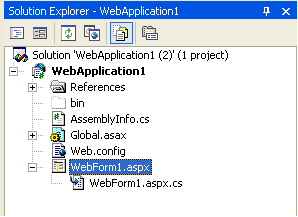
Control markup declarations are defined within the .aspx file itself. For example:

And corresponding protected field declarations are added in the .cs code-behind class that
match the name and type of controls defined within the .aspx file. For example:

ASP.NET does the work of wiring up a reference from this code-behind field declaration
to point to the declared control in the .aspx file at runtime.
Developers can then program directly against this control within their code-behind
file.
VS 2003 automatically adds/updates these protected control field declarations at the top of the
code-behind file (these are updated everytime a developer switches into WYSIWYG design-view):
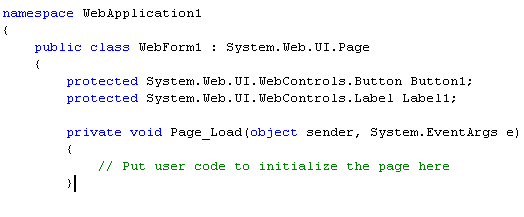
VS 2003 also then maintains a hidden region block inside the code-behind of tool-generated code
to register event-handlers and keep them in sync with the design-surface:
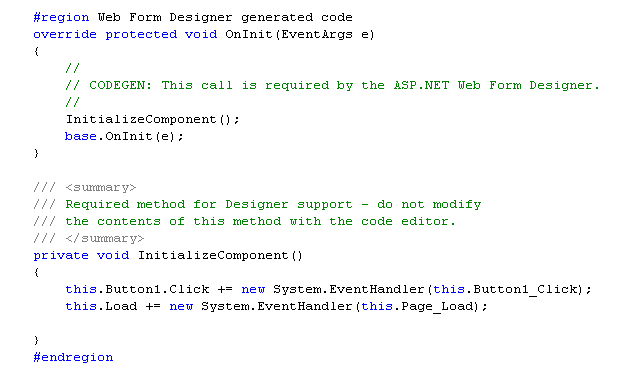
There are two common complaints/problems with this:
1) VS 2003 is adding/deleting code in the same file where the developer is authoring
their own code -- and accidental conflicts/mistakes do end up happening (for example:
some code that the developer writes can sometimes get modified or deleted by VS).
The tool-generated hidden block above is also a little "messy" for some people's tastes.
2) The control-declarations are only updated when a developer using VS 2003 activates
the WYSIWYG page designer. If a developer is only using the source-editor to customize
the page, they will not get control updates, and will instead have to add these
control declarations manually (which is a pain).
VS 2005 Code-behind Model for ASP.NET Applications
VS 2005 uses a code-behind model conceptually the same as VS 2003. Specifically, each .aspx
page continues to inherit from a code-behind class that contains protected control field references
for each control in the .aspx page:

What is different between VS 2003 and VS 2005 is that Visual Studio no longer injects
its tool-specific wire-up code in the developer's code-behind file. Instead,
it takes advantage of a new language feature in C# and VB called "partial types"
(or partial classes) to split the code-behind implementation across two files. One
of these partial class files is the developer-owned code-behind file that contains developer-written
event-handlers and code for the page. The other partial
class file is then a tool-generated/maintained
file that contains the protected
control field declarations and the other design-time code that Visual Studio requires.
The benefit of splitting them out into two separate files at design-time is that
it ensures that the code that VS creates and maintains never interferes (or deletes)
code that a developer writes. At compile-time, these files are compiled together
and generate a single code-behind class.
With the VS 2005 Web Application project model, the design-time partial class is
generated and persisted on disk by VS 2005. This new
design-time partial-class file has the
filename naming pattern: PageName.aspx.designer.cs. If you expand any
new page created within your VS 2005 Web Application project, you can see this file
listed under the associated Page.aspx file along with the
developer-owned code-behind file:
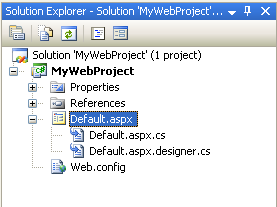
If you open up the code-behind file of the page (Default.aspx.cs), you'll then see the code-behind
logic of the page -- which contains all of the code and event handlers that a developer
writes (and no tool-generated "code-spit" content -- which means it stays very clean):
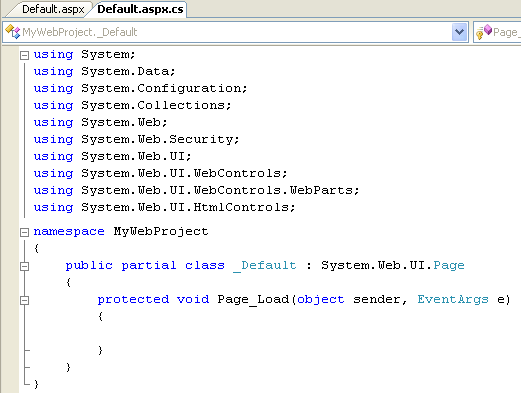
If you open the Default.aspx.designer.cs file, you'll then see the design-time
code of the page -- which contains the field declarations for controls within the .aspx
page:
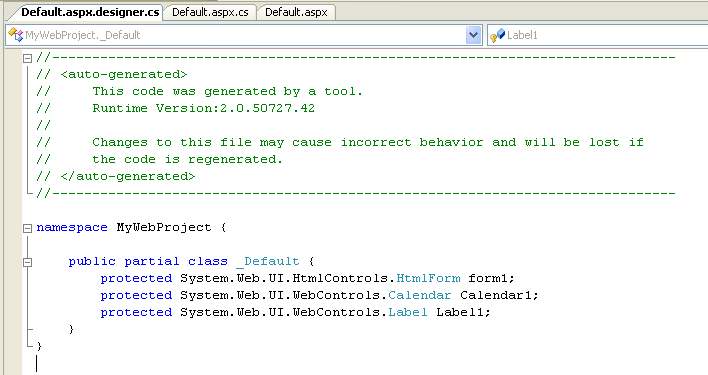
Because the MyWebProject._Default class is marked as "partial" in both of the above
two files, the compiler will merge them into a single generated class at compile-time.
This means that any variable, method or field generated in the default.aspx.designer.cs file can be
used from the default.aspx.cs code-behind file (just as if it was declared in the code-behind
file itself). For example, within the Page_Load event handler we could easily add the below code
that uses the "Label1" and "Calendar1" control:
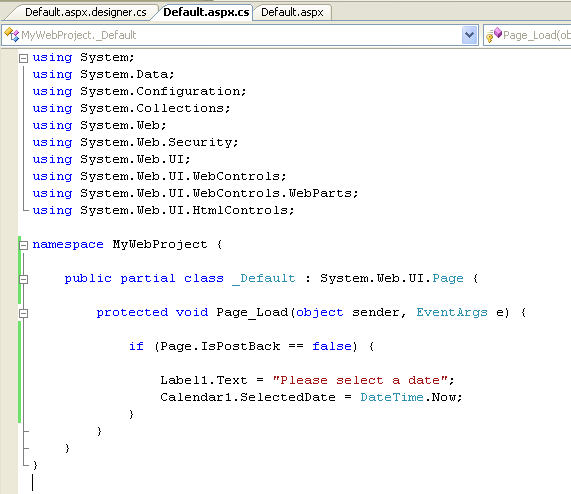
This will compile clean and run just fine -- because the "Label1" and "Calendar1" field references have been
defined within the default.aspx.designer.cs file.
When you do a build inside a VS 2005 Web Application project, all pages, user-controls,
master pages (and their associated code-behind files+design-time generated files), along with all
other standalone classes within the project are compiled into a single assembly. This
is the same behavior as with VS 2003.
Click here to go to the next tutorial.